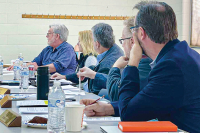Kephart’s fast friendship with the Barnetts
I have nothing to add to Gary Carden’s perceptive review of Horace Kephart’s posthumous novel Smoky Mountain Magic (Great Smoky Mountains Association, 2009) that appeared in last week’s “Smoky Mountain News.” I do, however, have a query regarding Bob Barnett, the real life model for one of the major characters — Tom Burbank. Burbank is the mountaineer who saves the hero, John Cabarrus, from sure death in a cavern supposedly “located” in the Nicks Nest watershed on Deep Creek above Bryson City. I place “located” in quotation marks because I doubt that such a cavern actually exists along that creek. Kephart more than likely had in mind one of the caverns situated in the Nantahala Gorge, which he “moved” a few miles eastward to suit his purposes.
Although I have written about Kephart since the mid-1970s, the importance of Barnett in his life and work hadn’t fully dawned on me until last month while writing the introduction for Smoky Mountain Magic. I have become quite interested in finding out what I can about Robert L. Barnett and would appreciate hearing from anyone with additional information. Here’s a summary from the introduction of what I know as of now:
In 1904, Kephart secured permission from a copper mining company that had gone into litigation to use one of its abandoned cabins on “the Little Fork of the Sugar Fork of Hazel Creek” in the present day Great Smoky Mountains National Park. Barnett was Kephart’s closest friend during the Hazel Creek years (1904-1907) and on into the early 1920s. Although Barnett was the younger man by 18 years, Kephart admired him tremendously. In a “Roving with Kephart” column published in “All Outdoors” magazine in 1921, he described a recent visit:
“He was the big, fat Bob who figures in ‘Camping and Woodcraft’ and ‘Our Southern Highlanders.’ He came years ago, to the old mine site where I’d been living alone with the bobcats and hoot-owls, and became caretaker for the company that had possession. It was an abandoned place — that is, no one ever lived there — and I welcomed a neighbor. Soon I shifted quarters to his house. We lived together, in various necks of the woods, for several years. Bob is now at Aquone, N.C., on the upper Nantahala, where he keeps open house for all comers.”
In Camping and Woodcraft (1906), Kephart credited Barnett as being “one of the best woodsmen in this country, a man so genuinely a scholar in his chosen lore that he could well afford to say, as once he did to me: ‘I’ve studied these woods and mountains all my life, Kep, like you do your books, and I don’t know them all yet, no sirree.’”
Many of the dialect witticisms entered in Kephart’s journals (now housed at Western Carolina University) were originally uttered by Barnett: “Bob whittled Old Pete Laney’s store-bought axe-handle for him and remarked: ‘Thar! I’ll see that Pete’ll have a decent axe-handle fer his women-folks to chop wood with, anyhow.’”
Related Items
In the “Back of Beyond” chapter of Our Southern Highlanders, when the two friends were stymied by the marauding tactics of a “slab-sided tusky old boar” (which Kephart has christened “Belial,” after one of Dante’s devils), Bob remarked in frustration: “That Be-liar would cross hell on a rotten rail to get in my ‘tater patch!”
The years after Kephart left the Great Smokies in 1907 until he returned in 1910 have been more or less a mystery. A letter recently archived at Western Carolina University from Kephart to Louis Hampton, a friend who still lived on Hazel Creek, provides additional information as to his whereabouts and activities. It is dated Oct. 5, 1909, and addressed from Lindale, Georgia (near Rome), where he was living with the Barnett family. Kephart advised Hampton that he had been “to Dayton to look after my father who was very sick [and] died a year ago. Then I went to New York and Pennsylvania, and back to Dayton, and finally came down here two weeks ago. I will stay with the Barnetts until spring, and then take a long trip through the mountains from Georgia to Virginia and Kentucky, taking photographs for my books.” In closing, he observed that, “Bob has a good job and a nice home. I have plenty of writing to do, and am saving money to buy a place in the Smokies. The Barnetts have a girl baby. She is a pretty little thing, but has one bad habit, for she pisses in my lap every day. Bob is fatter than ever, and his wife is quite stout. My own health is good.”
While in Lindale, Kephart was no doubt consulting with “Mistress Bob” — as he usually referred to Barnett’s wife — who was renowned for her backcountry culinary skills. His little volume “Camp Cookery,” published in 1910, was dedicated: “To Mistress Bob, who taught me some clever expedients of backwoods cookery that are lost arts wherever the old forest has been leveled.” She reappeared in the expanded edition of Camping and Woodcraft, wherein Kephart described with obvious delight “a mess of greens of her own picking ... an olla podrida ... cooked together in the same pot, with a slice of pork” that resulted in a ‘wild salat,’ as she called it.” And in Smoky Mountain Magic she emerged yet again as the model for Tom Burbank’s wife, Sylvia (“Sylvy”) Burbank.
Kephart returned to the Great Smokies early in 1910. He chose not to settle on Hazel Creek. The W.M. Ritter Company had begun operations there and was in the process of running a railway spur, the Smoky Mountain Railroad, up the watershed. It would not be the same. Instead, he stayed for a while, yet again, with the Barnett family, who had moved from Georgia to “the last house up Deep Creek.” This house was situated at the Bryson Place about 10 miles north of Bryson City—precisely where the Burbank family resides in Smoky Mountain Magic.
By the early 1920s, Kephart was settled in Bryson City and the Barnetts had moved to Aquone, a remote community in Macon County about 30 miles west of Bryson City. Barnett passed away in 1934, when he was 54 years old, and was buried near Mars Hill, North Carolina. It’s unlikely that Kephart admired or valued any of his friends more than he did Bob Barnett — not even George Masa, the Japanese photographer with whom he also formed a special bond.
George Ellison wrote the biographical introductions for the reissues of two Appalachian classics: Horace Kephart’s Our Southern Highlanders and James Mooney’s History, Myths, and Sacred Formulas of the Cherokees. In June 2005, a selection of his Back Then columns was published by The History Press in Charleston as Mountain Passages: Natural and Cultural History of Western North Carolina and the Great Smoky Mountains. Readers can contact him at P.O. Box 1262, Bryson City, N.C., 28713, or at This email address is being protected from spambots. You need JavaScript enabled to view it..









